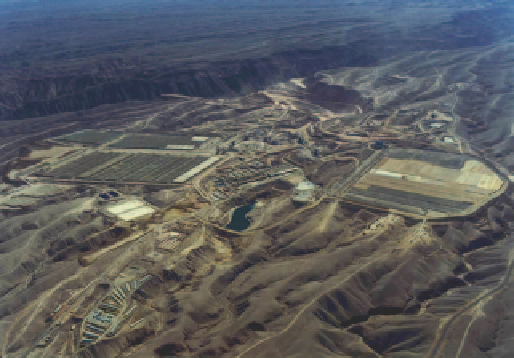Geoscience Reference
In-Depth Information
14.1.4
Mineralization Types
Supergene alteration formed during leaching of sulfide-rich
rock. Acids generated by the interaction of ground water
and sulfides leached Cu from sulfides and re-deposited it as
oxide Cu minerals above the water table and as supergene Cu
sulfides below the water table. The resulting rock is relative-
ly soft and commonly has vuggy veinlets of quartz, kaolinite,
alunite, limonite and jarosite.
Hypogene mineralization (HYP) is represented by pyrite
accompanied by chalcopyrite and bornite. Hypogene sul-
fides are deposited in all rock types as disseminations or in
veins and veinlets with quartz-feldspar-biotite, but are best
preserved under the base of the supergene layers or in vein-
lets in the transition zone between supergene sulfides and
hypogene. The average Cu grade of HYP is from 0.20 to
0.30 % (Campbell
1994
).
Supergene alteration and mineralization occurs in four
main zones, consisting generally from top to bottom of: (a)
leached zone (LIX) in which acid leaching has removed
most or all Cu mineralization; (b) oxide mineralization con-
sisting almost entirely of oxide Cu minerals (OX); (c) super-
gene Cu sulfide mineralization, dominated by the presence
of chalcocite and lesser covellite (S); and (d) a transitional
zone consisting of a mixture of supergene Cu sulfides and
hypogene Cu sulfides (MSH).
Supergene oxide and sulfide mineralization occur in mul-
tiple, sub-horizontal layers and vertical pods that extend over
a total distance of about 2,700 m East-West and 2,000 m
North-South. The top of the largest layers of oxide mineral-
ization is at an average elevation of 2,500 m, or from 50 to
200 m below the surface. Smaller, less continuous pods of
oxide mineralization are present above this elevation. The
leach cap above Cu oxides is 25-75 m thick.
Oxide (OX) is defined as material in which the ratio of
sulfuric acid-soluble Cu (SCu) to total Cu (TCu) is 0.5 or
greater. Chrysocolla is pervasive in the oxide Cu zone and
forms the dominant ore mineral. Brochantite, libethenite,
malachite, pseudomalachite, paratacamite, cuprite and teno-
rite can also be present (Cepeda et al.
1982
).
Supergene sulfide (S) is defined as material for which
the ratio of sequential Cu (sulfuric acid-soluble plus cyanide
acid-soluble) to total Cu is 0.8 or greater; and the ratio of
sulfuric acid-soluble to total Cu (SCu/TCu) is less than 0.3.
Chalcocite and lesser covellite replace or occur as coatings
of hypogene pyrite, chalcopyrite and bornite.
The transition zone (MSH) is defined as mineralization
with a ratio of sequential Cu to total Cu of from 0.5 to 0.8.
Cu is present as chalcocite, covellite, chalcopyrite and born-
ite. Chalcocite and covellite are preferentially present in
veins and fractures, but can occur as disseminations.
Fig. 14.2
Aerial view towards the N-NE of the Cerro Colorado opera-
tion, January 1999. Courtesy of Compañía Minera Cerro Colorado S.A.
Mineralization principally occurs in andesite, tonalite
porphyry and within small breccia bodies. The margins of
larger breccia bodies may be preferentially mineralized. The
siliceous cores of breccia units are normally weakly mineral-
ized. It is believed that intense hydrothermal alteration and
brecciation of the quartz monzonite culminated with deposi-
tion of Cu mineralization.
14.1.3
Alteration
Several hypogene alteration phases have been identified: po-
tassic, phyllic and propyllitic alteration zones. There is also
silicification of quartz-monzonite microbreccia and the mar-
gins of intrusive bodies, which may have preceded Cu miner-
alization, as well as supergene alteration. Potassic hypogene
minerals are preserved generally below the 2,450 m eleva-
tion where supergene leaching is less advanced, and is more
evident in quartz monzonite, quartz-monzonite microbreccia
and tonalite porphyry in the East deposit compared to the
West deposit. Andesite, quartz monzonite, microbreccia and
tonalite are altered to sericite/muscovite, quartz and pyrite in
the phyllic zone. Phyllic alteration overprints earlier potassic
alteration and is overprinted itself by the formation of kaolin-
ite and alunite during later supergene leaching. Propyllitic al-
teration is evident in outcrops within the Quebrada de Parca
and in some the outermost drill holes. Andesites are the most
common rock affected. The andesite is strongly chloritized
and contains disseminated and veinlet epidote. The ground-
mass of quartz-monzonite microbreccia is strongly silicified
locally. Silicification of andesite is also evident along con-
tacts with tonalite porphyry and quartz monzonite. Silicified
units could be weakly or strongly mineralized.

